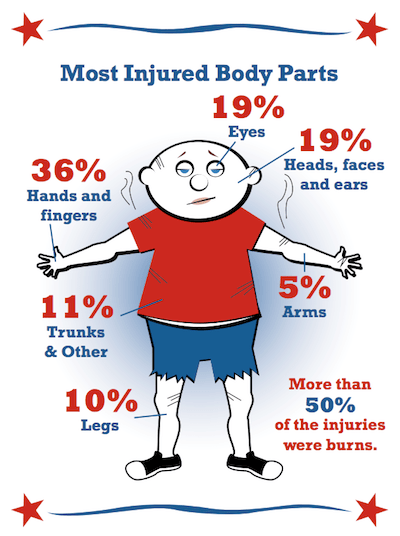Fireworks injuries skyrocket: what you need to know to keep your kids safe
Pediatricians have always been concerned about kids and fireworks, but now we have even more reason to be alarmed. New data shows a dramatic increase in the number of children seriously injured by these holiday festivities. Since 2006, the number of children injured by fireworks who were treated in the emergency room and released increased modestly, but the number of children who were treated in the emergency room then admitted to the hospital for further care increased a whopping 50% from previous years. These figures demonstrate that not only are more children getting hurt, but they are receiving serious and sometimes life-threatening injuries.
This dramatic rise in fireworks-related injuries in children correlates with the easing of many state laws governing recreational use of fireworks within the last decade. As the laws have been relaxed, more and more children have been injured.

Don’t let your child be one of them this Fourth of July. Here are some things you need to know to keep your family safe:
Recognize the risk
Fireworks can cause severe burns and eye injuries. Parts of the body most likely to be burned are hands and fingers followed the by head, face and ears. Injuries to the eyes are likely to be caused by lacerations and foreign bodies. Even sparklers, which many parents may regard as safe for their little ones can get as hot as 2,000°F and can cause serious burn injuries.
Ways to stay safe
In order to keep your joyful celebration from turning into an unwanted trip to the emergency room, make fireworks safety a priority. The American Academy of Pediatrics (AAP) advises that the safest way to enjoy fireworks is by attending community displays of fireworks that are run by professionals instead of using fireworks at home.
If you still choose to use fireworks at home, follow these safety guidelines from the Consumer Product Safety Commission:
- Never allow children to play with or ignite fireworks of any type.
- Avoid buying fireworks that are packaged in brown paper (this is often a sign that fireworks are meant for professional use).
- Children should have adult supervision at all times.
- Never place any part of your body directly over a fireworks device when lighting it. Once lit, back up immediately to a safe distance.
- Never try to re-light or pick up fireworks that did not fully ignite.
- Light fireworks one at a time then back up quickly.
- Never point or throw fireworks at or near another person.
- Keep a water source handy in case of a fire.
- Never carry fireworks in a pocket or shoot them off in metal or glass containers.
- Once fireworks are extinguished, douse the device well with water before discarding it to prevent a trash fire.
Have a happy and healthy holiday!







